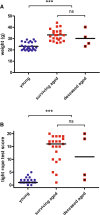Aged mice show an increased mortality after anesthesia with a standard dose of ketamine/xylazine
- PMID: 32257896
- PMCID: PMC7081538
- DOI: 10.1186/s42826-019-0008-y
Aged mice show an increased mortality after anesthesia with a standard dose of ketamine/xylazine
Abstract
Geriatric animal models are crucial for a better understanding and an improved therapy of age-related diseases. We observed a high mortality of aged mice after anesthesia with a standard dose of ketamine/xylazine, an anesthetic regimen frequently used in laboratory veterinary medicine. C57BL/6-N mice at the age of 2.14 ± 0.23 months (young mice) and 26.31 ± 2.15 months (aged mice) were anesthetized by intraperitoneal injection of 2 mg ketamine and 0.2 mg xylazine. 4 of 26 aged mice (15.4%) but none of 26 young mice died within 15 min after injection of the anesthetics. The weight of aged mice was significantly higher than that of young mice (32.8 ± 5.4 g versus 23.2 ± 3.4 g, p < 0.0001). Thus, aged mice received lower doses of anesthetics in relation to their body weight which are within the lower range of doses recommended in the literature or even beneath. There were no differences between deceased and surviving aged mice concerning their sex, weight and their motor performance prior to anesthesia. Our data clearly show an age-related increase of mortality upon anesthesia with low standard doses of ketamine/xylazine. Assessment of weight and motor performance did not help to predict vulnerability of aged mice to the anesthetics. Caution is necessary when this common anesthetic regimen is applied in aged mice: lower doses or the use of alternative anesthetics should be considered to avoid unexpected mortality. The present data from our geriatric mouse model strongly corroborate an age-adjusted reduction of anesthetic doses to reduce anesthesia-related mortality in aged individuals.
Keywords: Aging; Anesthetics; C57BL/6; Geriatric mouse model; Mortality.
© The Author(s) 2019.
Conflict of interest statement
Competing interestsThe authors declare that they have no competing interests.
Figures


Similar articles
-
Intraperitoneal Continuous-Rate Infusion for the Maintenance of Anesthesia in Laboratory Mice (Mus musculus).J Am Assoc Lab Anim Sci. 2016;55(5):548-57. J Am Assoc Lab Anim Sci. 2016. PMID: 27657709 Free PMC article.
-
Optimization of intraperitoneal injection anesthesia in mice: drugs, dosages, adverse effects, and anesthesia depth.Comp Med. 2001 Oct;51(5):443-56. Comp Med. 2001. PMID: 11924805
-
Alfaxalone-Xylazine Anesthesia in Laboratory Mice (Mus musculus).J Am Assoc Lab Anim Sci. 2019 Jan 1;58(1):30-39. doi: 10.30802/AALAS-JAALAS-18-000010. Epub 2018 Dec 20. J Am Assoc Lab Anim Sci. 2019. PMID: 30572981 Free PMC article.
-
Non-invasive echocardiographic studies in mice: influence of anesthetic regimen.Life Sci. 2001 Jun 1;69(2):213-22. doi: 10.1016/s0024-3205(01)01123-7. Life Sci. 2001. PMID: 11441911
-
Data Science and Geriatric Anesthesia Research: Opportunity and Challenges.Anesthesiol Clin. 2023 Sep;41(3):631-646. doi: 10.1016/j.anclin.2023.03.002. Epub 2023 Apr 18. Anesthesiol Clin. 2023. PMID: 37516499 Review.
Cited by
-
The neuroprotective effects of Chalcones from Ashitaba on cuprizone-induced demyelination via modulation of brain-derived neurotrophic factor and tumor necrosis factor α.Brain Behav. 2023 Sep;13(9):e3144. doi: 10.1002/brb3.3144. Epub 2023 Jul 4. Brain Behav. 2023. PMID: 37403256 Free PMC article.
-
Anti-tumor Effects of Cisplatin Synergist in Combined Treatment with Clostridium novyi-NT Spores Against Hypoxic Microenvironments in a Mouse Model of Cervical Cancer Caused by TC-1 Cell Line.Adv Pharm Bull. 2023 Nov;13(4):817-826. doi: 10.34172/apb.2023.084. Epub 2023 May 20. Adv Pharm Bull. 2023. PMID: 38022809 Free PMC article.
-
Protocol for assessing auditory brainstem response in mice using a four-channel recording system.STAR Protoc. 2022 Mar 16;3(2):101251. doi: 10.1016/j.xpro.2022.101251. eCollection 2022 Jun 17. STAR Protoc. 2022. PMID: 35313709 Free PMC article.
-
A Smartphone App for Individual Xylazine/Ketamine Calculation Decreased Anesthesia-Related Mortality in Mice.Front Vet Sci. 2021 Jul 22;8:651202. doi: 10.3389/fvets.2021.651202. eCollection 2021. Front Vet Sci. 2021. PMID: 34368269 Free PMC article.
-
Correlation of Visual System Biomarkers With Motor Deficits in Experimental Autoimmune Encephalomyelitis-Optic Neuritis.Transl Vis Sci Technol. 2024 Aug 1;13(8):1. doi: 10.1167/tvst.13.8.1. Transl Vis Sci Technol. 2024. PMID: 39087931 Free PMC article.
References
-
- United Nations. World population prospects: the 2015 revision. New York; 2015. https://www.un.org/en/development/desa/publications/world-population-pro....
LinkOut - more resources
Full Text Sources

